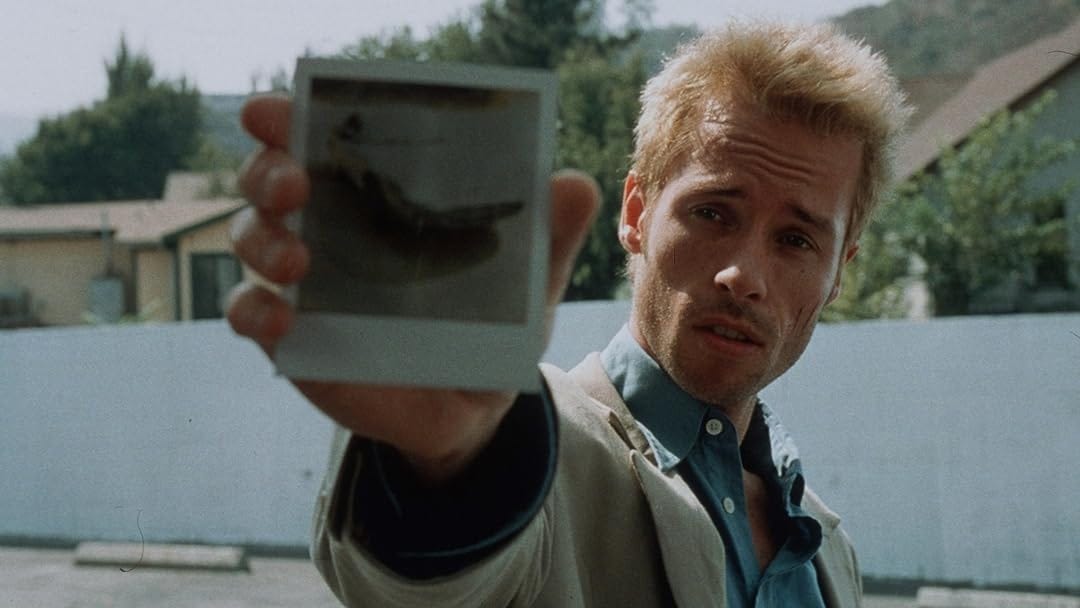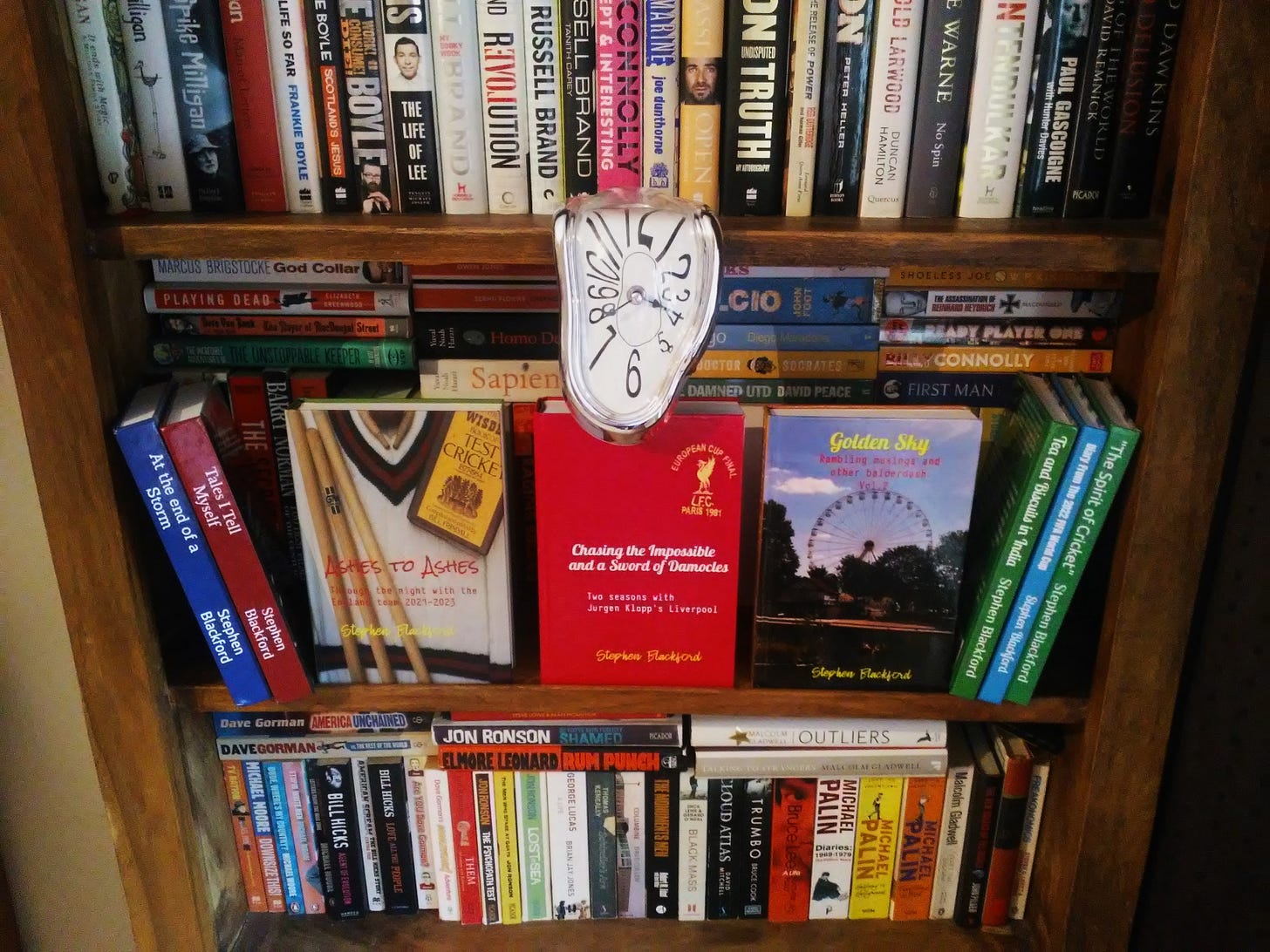
The film that started my twenty year plus cinematic love affair with the time twisting madness of Christopher Nolan and although the technical expertise and pushing of boundaries would follow with “Inception”, “Interstellar” and “Tenet”, “Memento” still remains my favourite all time Christopher Nolan film and indeed his finest ever achievement. It’s a touchstone to the themes that would pervade all of his films throughout his career and a somewhat sequel to his 1998 cinematic debut “Following”. Themes such as dislocation, the unreliability of memory, the elasticity of the principal of time, dreams, dreams within dreams, reality, loss, grief and the whole basket of human emotions that surround our very existence all are blended through the lens of Christopher Nolan and all coalesced perfectly for me around the turn of the Millennium when my love of Salvador Dali led me to books on existentialism, concepts and theories on life and our shared experiences and then Christopher Nolan produced arguably his first masterpiece in the first year of a brand new century.
I still have the original USA import of the DVD gathering Interstellar dust on my bookshelves along with Nolan’s other eleven films. Of the 12 films in the cinematic canon of Christopher Nolan I adore, truly adore, the middle 9 films (“The Prestige” is arguably his second masterpiece and “Oppenheimer” his third) and I only have reservations surrounding his debut film “Following”, “Insomnia” and particularly “Tenet” which I found artistically incredible but befuddling and uninteresting. Should you have an hour to spare, I’ve written extensively and spoiler free on every one of these 12 films and my opus blog article(s) can be found beneath the last introductory paragraph.
For now we must return to the majesty of “Memento” and from a cast list of just 14 credited roles, here are your trio of headliners:
Guy Pearce (Leonard) — Pre “Memento”, the Australian actor was incredibly well known and loved here in the UK for his relatively short stint on the Aussie daytime show “Neighbours” before in 1997 bursting onto the cinematic scene in the brilliant “LA Confidential”. Post “Memento”, Pearce has starred in “The Proposition”, “The Hurt Locker”, “The Road” and “The Kings Speech” all in the decade leading to 2010, before “Prometheus”, “Lawless” and “The Seventh Day” are all particular stand outs at the time of writing.
Carrie-Anne Moss (Natalie) — Six big screen films and a host of TV series led to Moss’ brilliant portrayal of “Trinity” in “The Matrix” before the following year starring here as the duplicitous Natalie. Moss would both complete a Matrix trilogy before starring in the fourth film but disappointingly I haven’t seen her figure in much else of note.
Joe Pantoliano (Teddy) — Honest Joe! One of my favourite actors and who brings such a vitality and effervescence to his role here before following Trinity into The Matrix! Starting his movie career in 1973, the great Joe Pantoliano has over 153 acting credits to his name (at the time of writing) but his performance here is just sublime.
So the choice is now yours: Either you can delve into a Christopher Nolan time portal and spend an hour with an unreliable narrator and his opus blog article on the entire incredible career to date of Christopher Nolan, just the 5 or so minutes it’ll take you to read my musings on his first masterpiece at the turn of the century (immediately below the links that follow) or join me fully in the Matrix and “Read Along” with me and my Youtube/Rumble videos linked below.
Whatever you choose dear reader and above all else, I hope you enjoy.
"Christopher Nolan and his entire cinematic canon" - original article
"Oppenheimer" (2023) - original article
Originally written and published in 2014
“Remember Sammy Jankis”
Based on the short story “Memento Mori” by his brother Jonathan, this is a cinematic triumph in every way for Christopher Nolan. Director of Photography Wally Pfister deserves early praise for the immersive lighting of the black and white scenes and a distinctly different and more gritty, real life feel to the standard colour scenes. This was to be Pfister’s first of numerous collaborations as DP on a Christopher Nolan film. Editor Dody Dorn also deserves early praise, as does David Julyan who returns to provide another subtle and haunting “electronic hum” of a soundtrack. He also provided a similar score to Nolan’s earlier film “Following” and also re-teams with the Director on his next two films.
As a music fan, the score is a particular favourite of mine reminiscent as it is of the 1980’s style of synthesised score, simple yet mournful and brooding. As a Radiohead fan it pleases me that Director Nolan originally wanted their eponymous track “Paranoid Android” to play over the closing credits but due to rights issues David Bowie’s “Something in the Air” is used. Even as a Radiohead fan, the use of Paranoid Android wouldn’t have fitted the film at all.
A back to front film in every sense of the word with the very first scene over the opening credits shown in complete reverse, sets the tone and theme of the film immediately. It also announces to the audience to keep up, stay alert and solve the coming constantly changing riddle wrapped in an enigma. Accompanied by a simple, methodical narration from “Leonard Shelby” (Guy Pearce) over the flashback scenes (always in black and white), we revert back to traditional colour for the “present day” scenes. Towards the end of the film, this process is also reversed, but it’s the looping of the narrative that immediately immerses you in the film. Scenes loop together with a crossover of the previous scene and not always in the ways you’d imagine even after re-watching several times. It disorientates the audience on purpose and can either be seen as a genius piece of cinema (me) or an immediate reason to disengage with the story. I enjoy the process of the looping thereby giving me more detail, more character and more layers of the film.
In a towering performance, Guy Pearce plays Leonard, striving to find the identity of his wife’s killer whilst suffering from the inability to form new, present day memories. His longer term memory is intact and, via the black and white flashbacks, we see Leonard as an Insurance Investigator and his main case, that of “Sammy Jankis” (great performance from Stephen Tobolowsky). Unable to form or remember new memories, Leonard resorts to tattooing numerous clues and statements to his body and lives by a constantly changing set of Polaroid photographs. All social encounters are portrayed awkwardly, as Leonard, unaware he’s had the same conversation previously, stares blankly ahead, with the line “I’m sorry I can’t remember you. It’s nothing personal” particularly telling. His blank stare grates on every character yet we are as aware as anyone that his actions are genuine and with no malice intended. These awkward interactions drive the film and combined with the looping effect again reveal layer after layer of the film and of our character’s real intent.
There are only fourteen characters in the entire near two hour film, two of whom share the majority of screen time with Leonard. Carrie-Anne Moss is superb as the calculating “Natalie” and Joe Pantoliano matches the intensity of performance by Guy Pearce as “Teddy”. All three main characters have a depth and duality. The constant flashbacks and looping progressively displays their duality whereby we see their extreme sides, both positive and negative, yet invest so much in them that we care in their outcome.
All three main characters have a decidedly dark and harmful side yet the twisting of the narrative persuades you to like them but why are Teddy and Natalie helping Leonard, and to what ends?
With the repeated use of these looping scenes, this excellent tale unravels and some of the twists can be anticipated but by no means all. As a first time viewer and now repeated viewer, you simply don’t piece the clues together as information overkill and intense story often distract you, which is the film’s biggest compliment and is in no way a criticism. It continues to remain fresh and challenging on repeated viewings and when watched recently I noticed that the first overt confirmation “clue” coming just fifteen minutes before the closing credits. Far superior to it’s early predecessor Following, it’s a triumph and masterpiece in every way. Trying not to give spoilers for this film in particular is very difficult! But equally I can’t do this justice from a review perspective either. It’s so unique and fresh even 14 years after it’s release.
Should you be reading this and haven’t seen the film, go see it.
Interestingly, many of the themes of the film are incorporated into his film Inception still 10 years away. They both share common themes of disconnection from life, memories versus fact, seeking revenge, the passing of time and the rationalisation of emotions. How do you rationalise emotions when you won’t remember them?
Detailing his condition (again) to Natalie mid-way through the film, Leonard tellingly states:
“The world doesn’t just disappear when you close your eyes”.
Thanks for reading. I hope this message in a bottle in The Matrix finds you well, prospering, and the right way up in an upside down world.






